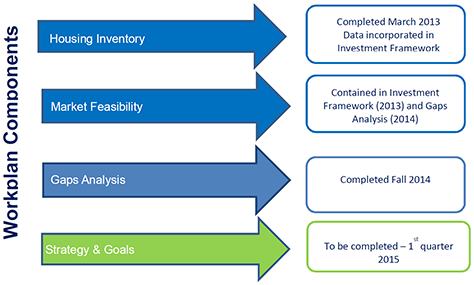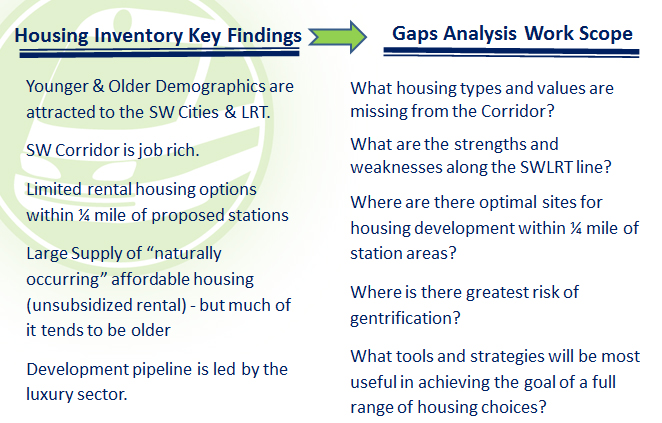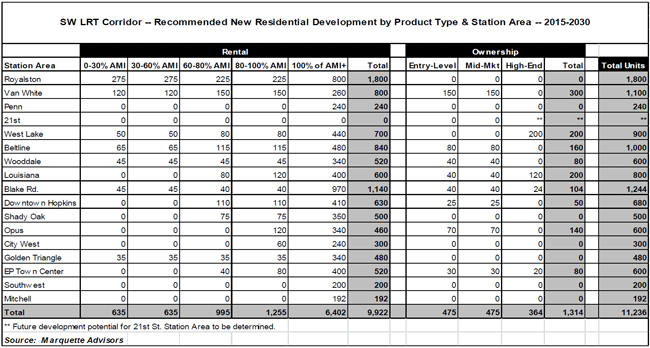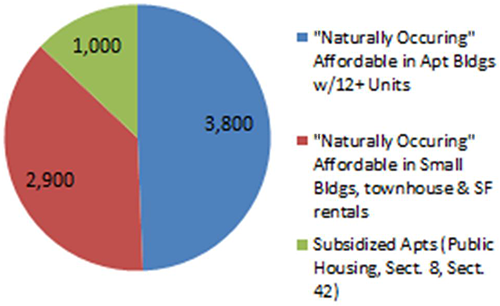This section describes, in brief, key findings and recommendations derived from the Housing Gaps Analysis. The information presented in this section are meant as a summary of, not a substitute for the body of the report, which contains additional information and detail critical to a full understanding of the analysis, the recommendations provided, and the context within which they were formulated.
Background & Context
Marquette Advisors was retained to provide a Housing Gaps Analysis related to the SWLRT Corridor. The "Corridor" as defined for purposes of this analysis comprises a ½ mile radius surrounding each of the planned LRT stations. The Housing Gaps Analysis is a critical component in the development of a corridor-wide housing strategy by SWLRT Community Works, along with its partner communities (Minneapolis, St. Louis Park, Edina, Hopkins, Minnetonka and Eden Prairie), and a full range of stakeholders. To date, considerable research and planning has already been done, inclusive of the SW Community Works Corridor Housing Inventory and the Investment Framework. The Housing Gaps Analysis interprets and builds upon these work elements and provides further research and analysis, culminating in recommendations intended to guide future planning that will “set the stage” for a “full range of housing choices” within the corridor.

The Housing Gaps Analysis provides recommendations for new residential development for the corridor as a whole, and for individual station areas, and identifies future supply gaps. The report discusses market inefficiencies and addresses the need for creative public/private partnerships that will help to facilitate the provision of a full range of housing choices in the corridor over the long-term.

Demographics -- Key Findings:
The SWLRT corridor is home to 37,000 residents and 19,000 households. The majority (about 2/3) are renters. Trend is likely to continue, based on demographics, lifestyle, and market factors.
The Twin Cities Metro Area is expected to grow by 11,000 to 13,000 households/year through 2030. 80% of growth is expected to be households without children, and nearly 1/3 of regional growth expected to be single-person households.
Millennials and Baby Boomers are having a major impact on Twin Cities housing market. Both segments are drawn to high-density multifamily housing products which feature “efficiency in living,” and connectivity to work, goods/services, public facilities, and entertainment/amenities. We expect that TOD housing products and SWLRT will appeal to both market segments.
Corridor Employment – Key Findings:
107,000 workers in corridor -- The corridor features a strong corporate presence, with a deep and diverse economic base. The corridor provides a “full range” of jobs, ranging from entry-level part time positions up to high-level management and executive positions in a wide range of industries.
Corridor workers a target for new TOD housing -- Less than 4% of the corridor’s 107,000 workers also reside within ½ mile of SWLRT presently. New housing products near SWLRT are expected to appeal to corridor workers.
Earnings & housing affordability -- Importantly, we note that a full 20% of the corridor employee-base earns less than $1,250 per month. A household with a single wage-earner at this level could afford a monthly housing payment of just $375 per month. Two workers at this level could afford a monthly housing cost of about $750. Worker earnings were a key factor considered by Marquette Advisors in developing recommendations for housing construction & preservation in the corridor.
Educational Facilities -- Key Findings:
Expect modest impact of housing development upon local schools – Considering demographic trends and expected development patterns, fueled by growth from single-persons households and households without children, TOD housing developments along SWLRT are not expected to have a substantial impact on enrollment at any one educational facility within the corridor.
TOD may boost open enrollment – The development of SWLRT will improve connectivity of residents with schools and, thus, will create opportunities for open enrollment, with students utilizing SWLRT to commute to/from their place of residence to school.
SWLRT housing will likely appeal to school teachers and other staff – The development of new workforce and market rate rental housing, as well as entry-level for sale housing, may in fact be attractive to teachers and other school staff who presently commute longer distances due to an affordability gap between current salaries and corridor housing costs.
Residential Development Outlook – Key Findings:
Market demand = 13,000 Outlook – Key Fin (2015-2030). This represents a gap between existing housing inventory and the number of households who will want to live along the corridor.
Recommended Development Goal = 11,000 new units. Tempered to reflect development constraints: land availability, land use factors, development cost factors, etc. However, at least 20% of these units still not feasible but for public/private partnerships and gap financing.

New unit mix - 90% rental, 10% home ownership -- Why? Considers demographics, economics and lifestyle factors. Regional and corridor growth dominated by small households. Market preference for efficient and convenience in housing, with strong connectivity to jobs and “urban” amenities. Approximately 1/3 of new construction recommended affordable up to 100% of AMI.
- 12% (1,300 units) - <60% AMI
- 9% (1,000 units) - 61% to 80% AMI
- 12% (1,300 units) - 61% to 80% AMI
Station Area recommendations for new construction take into account the following factors:
- Current housing inventory, demographic composition and economic base
- Land availability - ownership of undeveloped and/or under-utilized parcels
- Characteristics of surrounding land use (as-is and future expectations)
- Proximity to jobs, types of jobs & incomes levels, proximity to goods/services, public and educational facilities and other modes of transit
Mixed-income residential development a “best practice” related to inclusionary housing in the corridor -- Publicly owned sites present the best short-term opportunity for this type of development.
Housing Preservation – Key Findings:
Affordable housing is a primary asset within the corridor presently – Corridor features an estimated 7,700 units which are affordable to households earning <60% of AMI, representing almost ½ of the existing rental stock.
Limited risk of gentrification – Existing supply includes older product mix (1960’s/70’s vintage). Rents in many cases are well below 60% of AMI target. Age/quality and market obsolescence limits potential for major rent increases.
Housing preservation far less expensive than construction of new units – Providing new housing at levels which are affordable to households earning <60% of AMI, even up to 80-100% of AMI, is a significant challenge due to cost factors. Barriers to development are significant. Thus, particular focus should be given to preserving and improving the existing housing stock.

Corridor Strengths – Key Findings:
Strong demographics and high-quality real estate – The SW corridor features some of the region’s highest-quality and highest-valued real estate. High-quality housing stock, stable neighborhoods, close to parks and recreational opportunities, shopping and restaurants
Strong corporate presence and jobs base -- There corridor features depth and diversity in its employment base, with 107,000 jobs in the corridor. Proximity of the station areas to major employment nodes bodes well for connectivity and desirability of future TOD housing.
City staff are experienced and familiar with development tools – Our analysis and interviews indicates that city planning staff and administration have a firm grasp of redevelopment “tools” and experience in the types of public/private partnerships which will be required to achieve corridor housing goals.
Key Development Challenges:
Limited vacant land supply and shortage of publicly-owned sites – Much of the corridor is already built-out. The limited supply of developable land, paired with expected strong market demand for housing (and commercial forms of development) results in escalating land values. This poses the single-most significant barrier to the development of a full range of housing choices in many station areas.
Land use issues reduce redevelopment potential - Private ownership; highest and best use issues. Redevelopment is complicated and costly. It requires substantial investment or sale by private land/property owners. The objectives and risk tolerance of current property owners varies substantially.
Auto-oriented areas, lacking pedestrian/bike friendly amenities & connectivity – Several of the station areas are presently auto-oriented. Considerable investment in pedestrian/bike connectivity and public realm elements will be required in order to create the type of lifestyle environment preferred by prospective TOD residents.
Many stations lack street "vibrancy" and supporting commercial/restaurant nodes and public amenities – The region’s population base has shown a strong preference for housing in mixed-use neighborhoods which provide walkability and easy access to a variety of amenities – shops, restaurants, parks, trails, and recreational features, and entertainment. These elements should be incorporated in station area planning.
Recommendations & Next Steps:
Consensus, “buy-in” and commitment are critical to success – Joint powers agreements and representation of all corridor communities and stakeholder groups will be paramount to achieving The housing goals set forth by SWLRT Community Works.
Housing preservation strategy needed to invest in quality and sustainability of existing affordable housing stock – The strategy and investment model(s) should include the following elements:
- Deploys capital which invests in the quality, sustainability and long-term affordability of this aging housing stock. This will require dedicated funds and creative partnerships with private owners and non-profit development/management partners.
- Match services with the resident base -- fostering upward mobility within the community’s economy and housing market. Partnerships involving the public sector and varied advocate groups with corporate partners and educational institutions should be developed in order to provide services such as job/life skills education and household economics/financial advisory services and counseling.
Develop “branding” and promotions strategy for SWLRT lifestyle – What is TOD? And what kind of lifestyle will TOD housing and SWLRT provide? Promote market awareness of the benefits to TOD living in SW corridor.
Station area master planning -- Focus on stations with significant public land ownership and near-term development opportunities. This presents an opportunity for a “signature” development on SWLRT which demonstrates all desired “lifestyle” elements and provides a “full range” of housing choices. Success is critical in short-term developments, and sets the stage for future success in other station areas. To ensure success, the master planning process must engage a full range of stakeholders, both public and private. The Corridor Development Initiative (CDI) model is a best-practice and should be an integral component of future station area planning, as it provides a framework for collaboration and consensus building around quality planning.
Develop consensus and adopt housing policy goals – The partner communities should work together to build consensus around the concept of “full housing choice” and preservation and production goals. We suggest the creation of a coordinated SWLRT Housing Policy Overlay Zone, for the area within ½ mile of each LRT station. This area should be established for application of housing goals, policy and oversight. The structure and composition of which should be determined by the stakeholders, as buy-in from all corridor cities is key to success. We recommend that cities maintain development review/approval authority, utilizing their own “toolbox” and strategies which promote housing development and preservation which is consistent with the goals established within the SWLRT housing strategy.
Establish a $200m+ TOD Affordable Housing Fund -- Why? Existing tools/strategies are not enough to have impact at major scale. A dedicated funding source is needed to support construction of 1,300 new units at <60% of AMI and to preserve/improve 7,700 existing units affordable at <60% of AMI.
Fund Structure:
- Independently financed pool of funds that provides a return to investors
- More risk tolerant than traditional financing
- Patient financing with longer term payback
Possible Capitalization:
- Local foundations & intermediaries
- Family funds and partnerships
- Corporate interests (e.g. major businesses in SW corridor)
- Traditional institutional investment sources (insurance companies, etc)
While Marquette Advisors believes a program which provides a return to investors and generates cash flow for re-investment is the preferred structure, some type of public/private alignment might work under certain governing circumstances. While not a charge of this engagement, Marquette believes that some form of overarching authority driving the Fund would enhance achievement of housing policy and development/preservation goals.
A $200 million fund, properly designed and leveraged, should be able to provide key (and currently missing) capital to drive development and preservation which meets stated housing production and preservation goals.